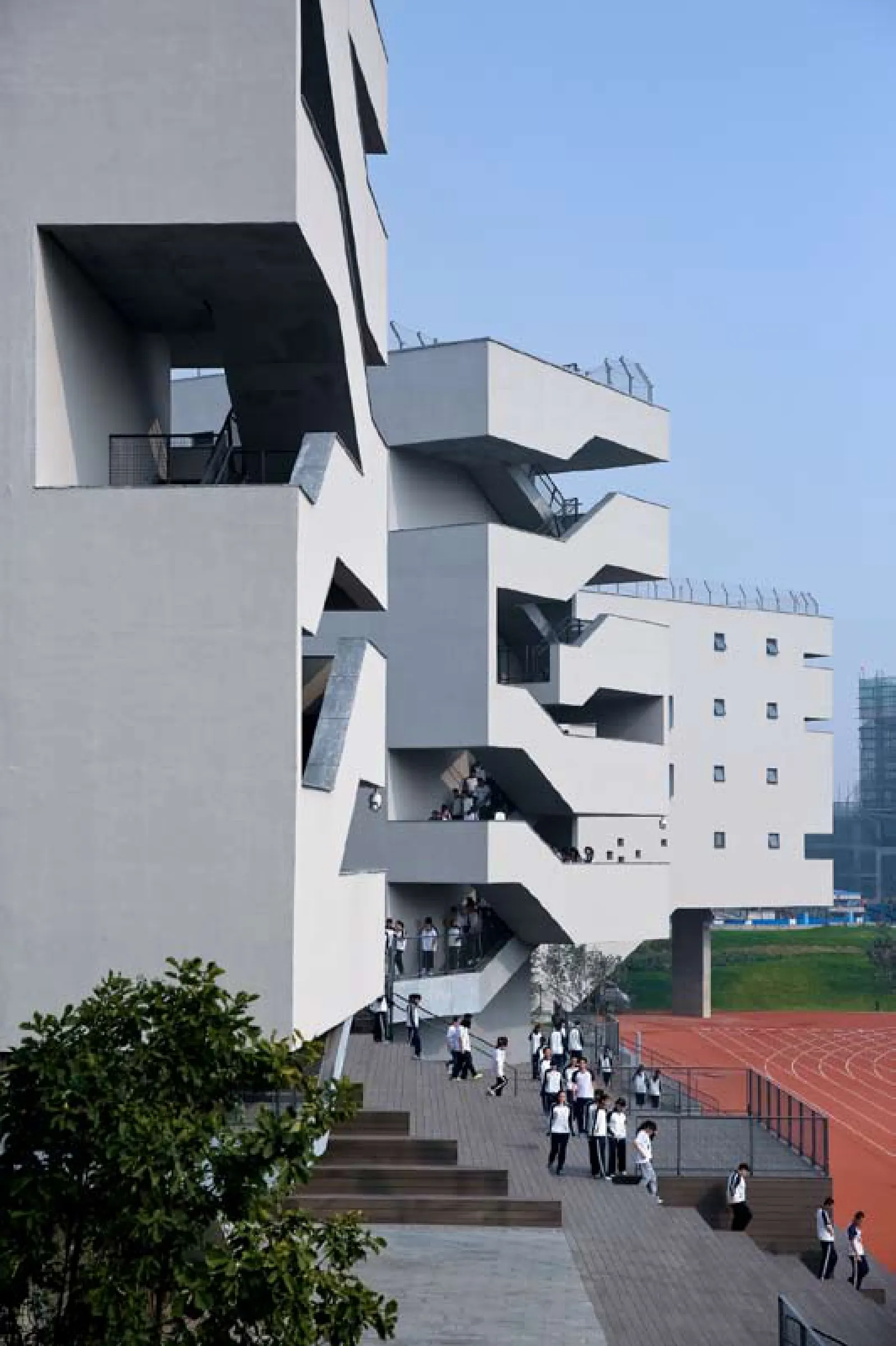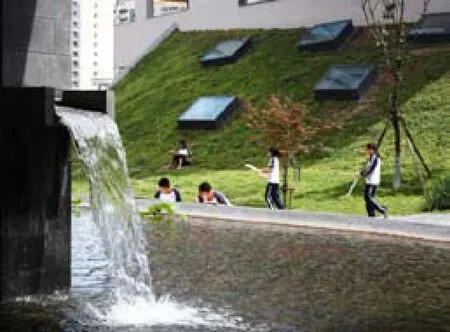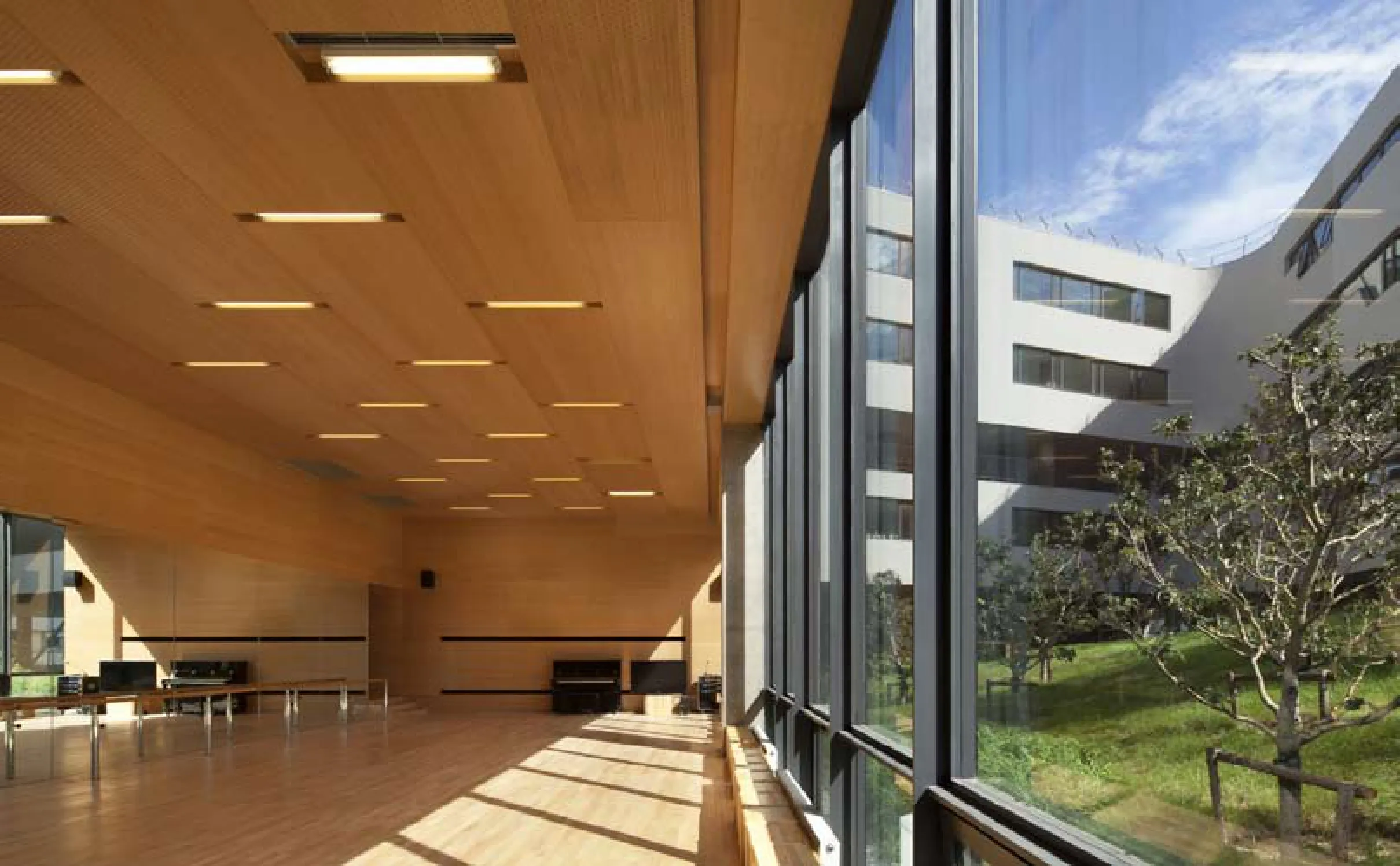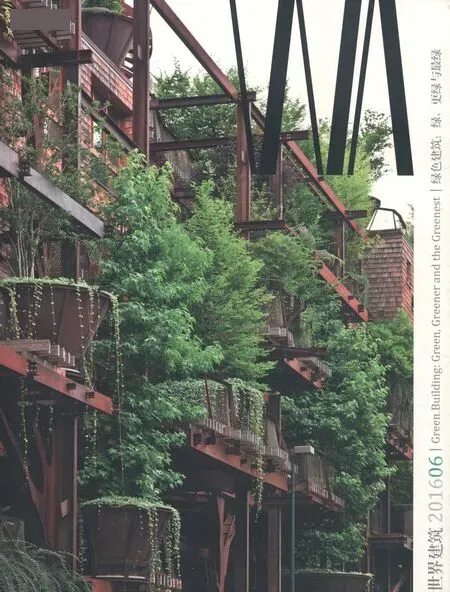田园学校
——北京四中房山校区,北京,中国
建筑设计:OPEN建筑事务所Architects: OPEN Architecture
田园学校
——北京四中房山校区,北京,中国
建筑设计:OPEN建筑事务所
Architects: OPEN Architecture

1
1 室外楼梯/Outdoor stairs
1 设计概念
这个占地4.5hm2的新建公立中学位于北京西南五环外的一个新城的中心,是著名的北京四中的分校区。新学校是这个避免了早期单一功能的郊区开发模式、更加健康和可持续的新城计划中重要的一部分,对新近城市化的周边地区的发展起着至关重要的作用。
创造更多充满自然的开放空间是设计出发点——这是今天中国城市学生所迫切需要的东西,加上场地的空间限制,激发了我们在垂直方向上创建多层地面的设计策略。学校的功能空间被组织成上下两部分,并在其间插入了花园。垂直并置的上部建筑和下部空间,及它们在 “中间地带”(架空的夹层)以不同方式相互接触、支撑或连接,这既是营造空间的策略,也象征了这个新学校中正式与非正式教学空间的关系。
下部空间包含一些大体量、非重复性的校园公共功能,如食堂、礼堂、体育馆和游泳池等。每个不同的空间,以其不同的高度需求,从下面推动地面隆起,形成不同形态的山丘并触碰到上部建筑的“肚皮”,它们的屋顶以景观园林的形式成为新的起伏开放的“地面”。上部建筑是根茎状的板楼,包含了那些重复性的和更严格的功能,如教室、实验室、学生宿舍和行政楼等。它们形成了一座巨构,有扩展、弯曲和分支,但全部连接在一起。在这个巨大的结构中,主要交通流线被拓展为创建社交空间的室内场所,就像一条河流,其中还包含自由形态的“岛屿”,为小型的群组活动提供半私密的围合空间。教学楼的屋顶被设计成一个有机农场,为36个班的学生提供36块实验田,不仅让师生有机会学习耕种,还对这片土地曾作为农田的过去留存敬意。
两种类型的教育空间之间的张力,及其各自包含的丰富的功能,造就了令人惊讶的空间的复杂性。为每类不同的功能所做的适合其个性的空间,使得这个功能繁杂的校园建筑具备了城市性的体验。与一个典型的校园通常具有的分等级的空间组织和用轴线来约束大致对称的运动所不同,这个新学校的空间形式是自由的、多中心的,可以根据使用者的需求从任意可能的序列中进入。空间的自由通透鼓励积极的探索并期待不同个体在使用上的再创造。希望学校的物理环境能启发并影响当前中国教育中一些亟需的变化。
在中国当前的环境下,可以说最迫切的问题和挑战就是人与社会之间以及人与自然之间的关系,而教育承担着巨大的责任。面对这些问题,我们以这个新校区项目作为试金石和力所能及的回应。

2
2 夜景,从操场看教学楼/Night view, from the sports feld to
teaching building
Concept
Situated in the center of a new town just outside Beijing's southwest ffth ring road, this new public school on 4.5 hectares of land is designed as the branch campus for the renowned Beijing No.4 High School. As an important piece in a grand scheme to build a healthier and self-sustainable new town, avoiding problems of the earlier monofunctional suburban developments, the school is vital to the newly urbanized surrounding area.
The intention of creating more open spaces filled with nature, something that urban Chinese students today desperately need, combined with the space limitations of the site, inspired a strategy on the vertical dimension to create multiple grounds,by separating the programs into above and below,and inserting gardens in-between. Te juxtaposition of the resultant upper and lower building, connected at the "middle-ground" in various ways, is as much an interesting spatial strategy as a signifier of the relationship between formal and informal educational spaces in the new school.
The lower building contains large and nonrepetitive public functions of the school, such as the canteen, the auditorium, the gymnasium, and the swimming pool. Each of these spaces with their varying height requirements, push the ground up from below into various mound shapes that touch the belly of the upper building; their roofs in the form of landscaped gardens become the undulating new open "ground". The upper building is a thin rhizome shaped slab that contains the more repetitive and rigid programs of classrooms, labs,dormitories and administration. Its mega form extends, bends, and branches, forming 6 different gardens in between. The main circulation spine within this mega structure is widened to allow rapid foot trafc during class breaks. It also accommodates some semi-enclosed spaces for small group activities,like a river with organic shaped islands. Te roof-top of the upper building is designed to be an organic farm, with 36 plots for the 36-classes of students in the school, providing students the chance to learn the techniques of farming, and also paying tribute to the site's pastoral past.
The contrast between the two types of educational spaces and the rich mix of programs within create a surprising spatial complexity. With the unique character for each different space, an urban experience is created within this complex of education facilities. Unlike a typical campus with hierarchical spatial organization and often clear axis to organize more or less symmetrical movements, this new school is free form and meant to have multiple centers that can be accessed in any possible sequences. It is a place with a free spirit that encourages explorations and awaits reinventions by different individuals. Hopefully the physical environment can inspire and initiate some much needed changes in the education system of China today.
In the contemporary Chinese context, arguably the most pertinent issue and challenge is that of the relationship among individual, society, and nature. Education bears great responsibilities. It is to these issues that this new campus project aspires to be both a touchstone and a response.

3

4
3.4 剖面/Sections
项目信息/Credits and Data
业主/Client: 北京市房山区长阳镇人民政府/Changyang Government of Fangshan District, Beijing
承建商/Construction: 北京中粮万科房地产开发有限公司/Vanke COFCO
主持建筑师/Principal-in-Charge: 李虎,黄文菁/LI Hu,HUANG Wenjing
设计团队/Design Team: 中山代次郎(项目建筑师),叶青,张浩,周亭婷,托马斯·巴森斯拉格尔,张畅,朱特·希格斯,王一帆,于清波/Daijiro Nakayama (Project Architect), YE Qing, ZHANG Hao, ZHOU Tingting, Tomas Batzenschlager, ZHANG Chang, Jotte Seghers, WANG Yifan, YU Qingbo
合作设计院/Local Design Institute: 北京市建筑设计研究院有限公司/Beijing Institute of Architectural Design Co.,Ltd.
绿色建筑顾问/Sustainability Consultant: 清华大学建筑学院/School of Architecture, Tsinghua University
幕墙顾问/Curtain Wall Consultant: 英海特工程咨询有限公司/Inhabit Group
照明顾问/Lighting Consultant: 莱亭迪赛灯光设计有限公司/Lighting Design Partnership International
声学顾问/Acoustics Consultant: 深圳洛赛声学技术有限公司/Clocell
景观设计/Landscape Architects: OPEN建筑事务所 + 北京世纪麦田园林设计有限责任公司/OPEN Architecture +
MILAND DESIGN
标识设计/Signage Design: 北京天树文化艺术传播责任有限公司/Beijing Trycool Culture and Art Development Co.,Ltd.
功能/Program: 共有36个初中及高中班级的中学/36-class junior and senior high school
建筑面积/Building Area: 57,773m2
设计时间/Design Period: 2010-2012
建设时间/Construction Period: 2012-2014
摄影/Photos: 苏圣亮/SU Shengliang (fg.1,2,10,12),
Spirit of Space (fg.5),夏至/XIA Zhi (fg.9,11,14),
陈诚/CHEN Cheng (fg.13)

5

6
5 人与空间的互动/Interactions between students and spaces
6 概念设计图解/Conceptual diagram
2 关于节能
这个项目是中国第一个获得绿色建筑三星级(其标准超过LEED金级认证)认证的中学。为了最大化地利用自然通风和自然光线,并减少冬天及夏天的冷热负荷,被动式节能策略几乎运用在设计的方方面面,大到建筑的布局和几何形态,小到窗户的细部设计。地面透水砖的铺装和屋顶绿化有助于减少地表径流,3个位于地下的大型雨水回收池从操场收集宝贵的雨水灌溉农田和花园。地源热泵技术为大型公共空间提供了可持续能源,同时独立控制的VRV机组服务于所有单独的教学空间,确保使用的灵活性。整个项目使用了简单、自然和耐用的材料,如竹木胶合板、水刷石(一项正在消失的工艺)、石材和暴露混凝土等。具体措施如下:
2.1 被动式绿色建筑设计策略
架空设计:在布局时充分考虑整个区域的引风策略,借助CFD模拟手段进行空间布局优化,夏季校园整体平均风速达到2.2m/s,有效改善了室外微环境。
屋顶绿化/种植屋面:减缓校园的热岛效应和屋面的冷热冲击,延长建筑屋顶的使用寿命。
自然通风:教学楼在风压作用下,通风换气次数达到了7.9次/h,宿舍楼达到了3.6次/h,有效改善通风。
天然采光:校园满足采光规范要求的主要功能区面积达到了91.7%。风雨操场条形天窗,引太阳光线进入风雨操场内部;音乐教室、技术教室设立斜天窗进行漫反射采光;阶梯教室采用南北双侧窗的采光方式。
遮阳设计:教室均朝南向布置,窗套外遮阳形式可有效地遮挡太阳辐射进入室内;西侧办公采用三角式外遮阳,既保证了室内天然采光,又最大程度地遮挡住直射光,解决了西晒问题。
2.2 空调设计
考虑教室、办公及宿舍的间歇性和即时使用性特点,这些区域夏季制冷采用可灵活控制的多联机系统。
地源热泵:在操场地面下共铺设144根垂直双U型地埋管,孔深120m,为礼堂、餐厅等大型空间制冷供暖。
新风热回收:礼堂、门厅处采用全空气系统、排风全热回收技术,热回收全年可节能4,4000KWh。
2.3 可再生能源与节水设计
项目采用太阳能热水系统作为一次热源,下沉的操场及篮球场兼具雨水收集利用功能,并设立容积750m3的蓄水池。周边有市政中水供给,市政中水供给日平均用水量110.2m3/d,非传统水源利用率达到了45.0%。卫生间内采用节水卫生器具,节水率达到8%。
2.4 建筑能耗分析
通过围护结构全年模拟优化、被动式设计、新风热回收、地源热泵、太阳能热水、照明节能设计等建筑节能策略,建筑的全年采暖空调能耗从516,000KWh降低到425,000KWh,采暖空调系统的节能率达到17.6%。照明系统节能率达到22.4%。

7
7 绿色建筑策略/Green strategies diagram
Sustainable Design Intent and Innovation
Te project is the frst high school in China to achieve Chinese Three-star Green Building Rating (a standard that exceeds LEED Gold). In this large school for 1500 students, one typical challenge is the amount of energy required to heat and cools those large shared facilities, like the gymnasium,auditorium, and dining hall. Another challenge is the flexible control requirement as classrooms and labs are often not used at the same time. We dealt with these issues separately. Large shared facilities are set to be partially below grade with fully landscaped roofs, this envelope greatly reduces the energy load of these spaces. Then, geothermal ground-source heat pump, a sustainable source of energy, is used for the cooling of these large spaces. For the upper building containing classrooms and labs, independently controlled VRV units are employed to ensure fexible operation. Te roof-top of the teaching building is made into an urban farm,with 36 plots for the 36-classes of students, not only reduces the heat gain and loss of the spaces down below, but also provides students opportunities to learn farming.
The dormitory hot water is supplied by solar panels installed on the roof. Almost all lighting fixtures in the school building are energy saving type using LED luminaires.
Passive solar strategies are adopted throughout the building. The building's spatial arrangement is optimized with CFD simulation tools. Average wind velocity on campus during the summer reaches 2.2m/s, effectively improves the microclimate. Classrooms are arranged in single loaded slab building branches, all south facing with projecting window frames. Te depth of the projection (450mm from outer wall) is calculated to effectively cut down direct summer light and minimize glare.
Three large underground water retention basins collect rain water from the athletics feld for irrigation of the farms and gardens. Most of the ground paving is permeable to reduce the surface runoffs.
Throughout the project, simple, natural,durable, economic and environmental-friendly materials are used, a few examples here:
-Outdoor permeable ground pavers are made from compressed Gobi desert sand and recycled concrete aggregate.
-Bamboo plywood is used throughout the school. Bamboo is a fast regenerating grass, easily workable.
-Student lockers are made by strawboard which is entirely made of straw, an agriculture waste abundantly available. Strawboards are 100% recyclable and biodegradable and do not incorporate any harmful substances.

8
8 生态可持续系统分析/Sustainability system diagram

9

10

11
9 夜景,竹园上空/Night view, above the bamboo garden
10 三角形窗套外遮阳/Triangular window frame shading
11 悬挑的阶梯教室/Cantilevered lecture hall
评论
布鲁诺·斯塔尼奥:这个项目是一个非常冷静的建筑表达,令人回想起1960年代的现代主义建筑。 建筑外部的白色墙体与彩色室内之间的对比,体现了细心的建筑设计和景观设计。可见该校的职业教育项目综合了学术成绩和表现评估;体育和农业学科成为通过实验进行教学的科目。种植区域位于绿色屋顶上。该项目突出了标准的建筑水准,并反应出了学生的纪律性。(王欣欣 译)
王海松:这是一组空间利用极度紧凑的校园建筑,其地下、地面、屋顶层的充分利用,既满足了功能联系,又为师生创造了丰富的交往空间、活动空间,还具“节地”的效果;由体育馆(风雨操场)、食堂、礼堂等建筑体量形成的绿色山丘为校园增色不少,且有实际的节能意义;建筑群所采用的绿色技术比较妥帖,并无堆砌的痕迹,且与建筑形态的结合比较平实。在少雨的北京地区,设置大型的雨水回收装置似较浪费,应注重于食堂、卫生间、浴室的废水搜集、回用。
Comments
Bruno Stagno: The project has a very sober architectural expression in which modern architectural reminiscent of the 1960's, is appreciated. The outer white walls of the building contrast with the colorful interior that shows a careful design as well as landscaping. It is understood that the vocational educational program integrates academics with performance; sports and agriculture become a unit subject that is learned by experimenting. Te planting areas are located in green roofs. Te building highlights the quality of standard construction and student discipline seen in the images.
WANG Haisong: Tis is a group of compact campus buildings with extremely utilization of space. The fully use of the underground, floor and roof layer meets the functional connection between different spaces and creates for teachers and students spaces of communication and activities, with also the landsaving effect. The green hills formed by the buldings of stadium a(wind and rain playground), cafeteria,and auditorium considerably burnish the campus with practical significance in saving energy. The environment-friendly technology applied to the architectural complex is appropriate with no trace of excessive decoration but simple and natural combination with the architectural form. In Beijing and neighboring areas, with little precipitation, to set up a large rainwater recycling system seems to be a waste. However, importance should be attached to the collection and reuse of waste water from the dining room, toilet and bathroom.

12

13

14
12 风雨操场上方的山丘/Te mound above the gymnasium
13 阶梯教室下方的荷花水池/Lily pond under the lecture hall
14 可见花园全景的舞蹈教室/Dance room with full garden view
Garden School: Beijing No.4 High School Fangshan Campus, Beijing, China, 2014

